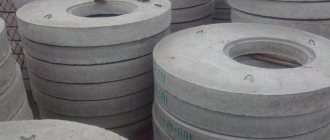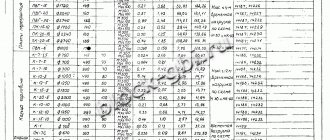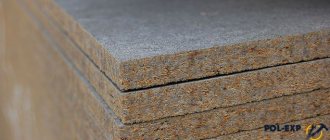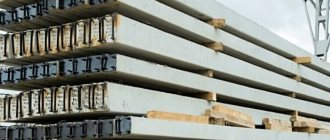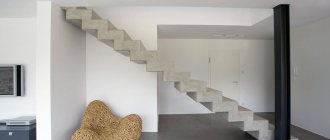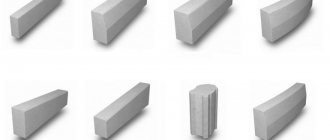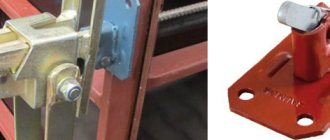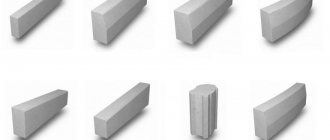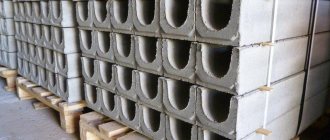The well cover is reinforced concrete - a round slab of reinforced concrete with a designed hole for installing a hatch. Products may differ in height, hole size, outer diameter and sometimes in shape (some are square, for example).
The concrete cover is an important structural part of any prefabricated well; it is installed directly on the ring with reliable fixation with a cement mixture. For ease of installation, the covers are equipped with mounting loops around the perimeter. Afterwards, a hatch is mounted on them, allowing for maintenance and operation of the structure.
Concrete covers are usually important structural elements of water supply and sewer systems. The product protects the well shaft from the risk of precipitation, dirt, dust, and debris getting into it. In addition, the cover significantly increases the level of operational safety of the structure, eliminating the possibility of animals and people falling into the shaft. Often, wells without covers are prohibited from being put into operation.
Before choosing covers for wells, you need to carefully calculate everything, determining the main parameters and requirements for the product. It is important to know the required type of element and design features, diameter, height, thickness, requirements for strength, durability, etc.
Application and Description
A manhole cover is an essential part of any type of engineered well. Thanks to such a cover, the shaft is securely closed and it is possible to continue laying the road surface, while leaving the possibility of unhindered access to communications due to the presence of a functional opening closed by a hatch.
Reinforced concrete well covers are used for:
- Drainage mines
- Creation of gas/water systems
- Ventilation pipes
The main function of the cover is to reliably protect all communications from any environmental influences, from vandals to rainwater. Unauthorized access to systems is excluded, as is the entry of debris and water. The products are made from modern durable concrete using the vibration-compression method with reinforcement, so they are frost-resistant, waterproof, resistant to mechanical stress, and durable.
Strength is due not only to the fact that the lids are made of high-quality concrete, but also due to reinforcement. The reinforcement frame eliminates the risk of deformation of the structure and destruction of the entire product.
The hole for the hatch on the cover can be located exactly in the center or offset to the side - this parameter is not of great importance and is simply taken into account during installation and further operation.
The holes are made rectangular or round. The round one increases the mechanical strength of the lid, the square one is used to create storm, drainage, and various types of sewer systems, since a drainage grid is mounted in them.
Main design features of well covers:
- Presence of a hole for a hatch - may not be provided when the well needs to be taken outside the site and maintenance is not expected
- All types of products can be made with a figured fold or simply smooth ends. Quarter slabs are marked with the letter “H” and are used for installation on a locking connection
- Covers may already have a hatch - in this case their cost is higher than without it
House-shaped finial
A cover for a well of this shape will not only fulfill its direct function, but also act as a decoration for the summer cottage. The house is a gable roof on a small frame; a hatch is made in one of the roof slopes.
The house can be built from timber, metal, covered with siding, and decorated to your liking.
A wooden house looks beautiful, but in order for it to maintain its appearance, it needs to be looked after: remove the old layer of varnish or paint and recoat it, apply protective compounds. A house on a metal frame, covered, for example, with siding, does not require such maintenance. There are also ready-made metal, plastic and wooden houses on sale. The house can be open or closed.
Existing types
Any well cover is a standardized product that corresponds to the established dimensions. The structural parameters of the element are determined by the purpose and characteristics of the vertical shaft of the mine. The outer shape can be square/round, the inner hole can also be rectangular, round, square, offset round or two.
The ends can be smooth or with a rebated profile (under the ring where the manhole cover is installed), intended for mounting a rectangular grate for drainage. The load capacity of the cover is determined by the scope of application - the products are concrete and reinforced concrete (more durable due to reinforcement).
Dimensions and weight correspond to the parameters according to GOST; they can be found in special tables or checked with the manufacturer or seller.
Advantages and disadvantages
When choosing a cover for a well, you need to accurately calculate and think through everything. It is also advisable to study the features, pros and cons of the product itself.
The main advantages of a concrete well cover:
- Long service life
- High strength and reliability indicators - you can install road surfaces on the cover and not be afraid that it will sag or collapse
- Simplicity and ease, high speed of installation
- Environmentally friendly and safe – the material does not emit toxins and has no impact on people’s health and life
- Resistance to frost, high temperatures, moisture
- Resistant to rotting, mold and mildew
- Reliable protection of the communication system - the heavy cover is difficult to lift or move under normal conditions
- Large selection of external shapes, holes where the manhole cover will be mounted, sizes and other parameters
Among the shortcomings of the product, it is worth mentioning such as the need to use special equipment for installation (due to the heavy weight), lack of aesthetics and beauty, serious requirements for the production process (if the technology is not followed, the lid will not meet the declared characteristics and will not be strong enough), complexity in creating a hole in the lid.
Step-by-step instruction
Depending on the design of the well shaft and the frame, the covers can be made in the form of a circle or a rectangle; when opened, they can be completely retracted or hinged. Let's take a closer look at how to make a well cover with your own hands.
Wooden cover
The main advantage of wood is its high manufacturability and ease of processing with hand tools.
But it should be taken into account that the tree needs protection from aggressive external influences - dampness, temperature changes, sunlight, wood-boring insects. To do this, the structures are treated with antiseptic substances and paints and varnishes. In this case, a wooden well cover can last for decades.
The most suitable tree species for installing a cover are deciduous. These are linden, birch, oak. You will need boards 2 cm thick, or “inches”, 150 mm wide, as well as 4x4 cm bars. The simplest design of a well cover is a regular wooden shield covering the neck from above. We measure the width of the well's neck, and according to its dimensions we knock together a shield: we tightly pack boards onto the base of 2 bars. If necessary, the shield is shaped into a circle using a hacksaw or electric saw.
Manufacturing techniques
Covers for wells are made from heavy concrete of strength class B15/B20. The exact choice of cement and concrete grade depends on the scope of application and standard size of the product. Concrete is poured into a mold with a reinforcing frame, vibrated until the solution is completely compacted, and subjected to heat treatment (dried under hot steam), which makes the lids especially durable.
Thermally hardened carbon steel is used for reinforcement. Welded flat meshes made of hot-rolled wire made using resistance spot welding can be used. All metal elements must be treated with special anti-corrosion compounds.
Precast concrete products of this type are made in accordance with the requirements of GOST 8020-90, which specifies the parameters for protecting the reinforced frame from corrosion, rigidity, tempering/design strength, resistance to crack propagation, frost and water.
GOST also specifies the grades of steel from which reinforcement cages, wire, and embedded products should be made. It is allowed to use hot-rolled rods of classes AI-III, wire of class Bpl, thermomechanically hardened steel in At IIIC, IVC rods.
How to choose a well cover
Due to the fact that a well cover costs and weighs a lot, purchasing an unsuitable product or installing it and then dismantling it can take a lot of effort and money. Therefore, the choice of element must be approached carefully in order to immediately find what you need.
What to consider when choosing a well cover:
- Size – the diameter of the cover must exactly match the diameter of the well (or slightly larger): a smaller diameter will make installation ineffective, and a product that is too large will entail additional financial costs.
- The thickness of the lid is usually 10-20 centimeters. If it is planned that cars will drive on the cover and people will walk, it is better to choose a thicker thickness; for installing a regular well, 10 centimeters is enough.
- The shape of the hole for the hatch can be round or square (rarely rectangular). The standard option is a round hole with a diameter of about 70 centimeters; a square hole is chosen for installing a drainage grid.
- The location of the hole for the hatch is in the center or offset to the edge, the choice is determined only by ease of use.
- Appearance - the cover must be free of holes and chips, releases of fittings, cracks and other defects.
- Storage in a warehouse - it is allowed that there are a maximum of 6 products in a stack using wooden spacers, otherwise cracks may appear from the pressure of the weight, causing leaks.
Installation
Now we propose to consider the sequence of how to lay the bottom and PP during the construction of the well.
- At the first stage, a pit is made, and water is pumped out if necessary.
- Next, the bottom is constructed. Before laying it, it is necessary to carefully level the bottom of the pit. The soil is pre-compacted and a sand cushion is prepared, which is also compacted. The product is placed strictly level.
- The first ring is installed on the cement on top of the bottom. To ensure the necessary tightness. Additionally, the joints are covered with waterproofing.
- All subsequent rings are installed and fastened with special metal brackets.
- The ceiling element is laid on top.
Marking
All factory products are marked with letters and numbers according to the standard.
How is a reinforced concrete well cover marked:
- The first digit in the range 1-4 is the size number
- The letters PP mean “floor slab”
- One or two numbers - indicate the outer diameter in decimeters
- One digit after the hyphen in the range 1-3 – indication of load-bearing capacity class
- Additional data - features of the cover: the displacement of the hole is indicated by the letter C, the presence of a figured fold for the lock ring is identified by the letter H
The maximum outer diameter of the cover can be from 0.8 to 3.3 meters, the height varies between 12-18 centimeters. Hatches can be included, made of one material or another.
So, for example, the marking 2PP 15-2 says that: this is a lid with the second number of a standard size, its diameter is approximately 150 centimeters (15 decimeters), the thickness is 15 centimeters, the strength class is second.
Product load classes:
- 1 – withstands uniform pressure up to 5 kPa, collision with vehicles is not allowed, the head can be raised above the landscape by a maximum of 0.3 or deepened by 3 meters.
- 2 – you can run over the wheels of vehicles with a load of class A11.
- 3 – dynamic/static types of loads are possible with the wheels of a single NK-80 vehicle.
In Moscow and the regions there is a fairly large selection of slabs of various sizes and with optimal characteristics, so choosing a product that meets specific requirements for the installation of different types of systems will not be difficult.
Special designs
If standard sizes do not suit the task, it is possible to order individually.
It is necessary to clarify in advance all the dimensions and height of the structure, decide its future shape, draw up a drawing or sketch of the project, and take photographs of the site of future installation. Having this set in hand, you can select a contractor for the order and calculate its cost. Decorative lamps are installed in the manufactured structures. Illumination and evening lighting will not only create a combination, but will also allow you to confidently move around the area, feeling safe. The use of automation will allow you to turn on and off the lighting at a certain time or depending on sunlight, dim or partially turn off the lighting late at night to save energy.
Installation
The reinforced concrete well cover is quite easy to install. The main thing is to pay attention to each stage and do everything as carefully and efficiently as possible.
How to install a concrete well cover:
- When installing a heavy lid, order special vehicles for loading in advance or involve the required number of workers
- Installing the cover on the shaft well, precise edge alignment
- Hatch installation
Now it’s worth considering everything in more detail. Installing the cover is the final stage of forming the shaft/well. First you need to seal all the seams of the formed type-setting “glass”, as well as the joint of the upper cut of the ring, where the concrete lid will be fixed.
Next, the cut is primed and covered with a cement mixture based on glue. If there are folds, then you need to lay a hemp rope around the perimeter and cover it with a solution. Prime the already hardened mixture again. Next, carefully and observing all safety measures, the cover is moved manually or on a lift boom to the installation site.
The product is placed on the head of the upper ring. The joint between the ring and the slab is carefully and hermetically sealed. The hole is closed with a hatch if it is not installed at the factory. Hatches can be made of plastic, cast iron, concrete, etc., the main thing is sufficient durability and strength. If it is planned that vehicles will walk on the lid, it is advisable to choose cast iron.
Concrete products for wells
The concrete cover can be called universal; it is suitable both for concrete country wells and for laying gas pipelines and network systems in industrial construction.
- not afraid of frost;
- the strength indicator is high;
- long service life;
- water will not get inside the tank through such an overlap.
Kawabanga! Instructions for creating a stone from cement
Choice
Concrete set
When choosing this product you need to pay attention to the following points:
What to consider during installation?
Making a concrete cover for a well with your own hands does not require as much time and effort as it might seem at first glance.
For this you will need:
- concrete solution;
- reinforcing mesh;
- the form in which the mortar with reinforcing mesh will need to be laid.
Manufacturing technology
Most often, concrete well rings are covered with a concrete cover. It can be either in the form of a hatch with a hole, or in the form of a solid slab. As an example, let’s consider the technology for manufacturing a concrete product with a hatch that will have the shape of a square.
How much does a concrete product for covering a sewer well weigh?
To protect sewer shafts from contamination, a concrete hatch is used. As a rule, for such wells a lid weighing from fifty kilograms is used.
Types and weight of hatches:
- the weight of the sidewalk hatch is within five tons;
- the weight of a “light” reaches a maximum of fifteen tons;
- the weight of “heavy” ones reaches twenty tons.
In order to understand which lid you should choose, you need to familiarize yourself with other types of lids.
How to make it yourself
Independently creating a reinforced concrete well cover does not allow you to achieve high strength of the product, but it makes it possible to significantly save money where some parameters can be neglected.
How to make a lid with a square hole 70 by 70 centimeters:
- Preparation of materials: M200 concrete, reinforcing bars, formwork board, plastic film.
- Digging a trench 10 centimeters deep in a free area of the territory with a diameter that exactly repeats the diameter of the upper ring of the well for which the cover is being created.
- Installation of formwork in the center of the trench to create a hole for the hatch.
- Covering the bottom and walls of the formwork structure with polyethylene.
- Pouring the first layer of concrete 5 centimeters thick.
- Laying reinforcement.
- Filling the second layer with a thickness of 5 centimeters.
- Drying concrete, proper care of it (after some time the product can be taken out and moved to a drying room).
A reinforced concrete well cover is an important and effective structural element, the selection and installation of which must be taken very seriously. In this case, the communication well and the slab covering it will last for many years, guaranteeing strength and reliability.
Main functions, materials used
It would seem that the main and only task of the cover is to provide protection against the entry of debris into the well: leaves, household garbage - pollution is carried away by the wind, which is usually very strong in an open space. But that’s not all, because there are other functions, the implementation of which allows you to use water all year round without unnecessary difficulties, namely:
- providing protection from direct sunlight, which is more conducive to the growth of algae at the bottom of the well;
- insulation of the structure, without which in winter the liquid will instantly freeze, and as a result not only the owner will suffer, who will lose a source of water, but also the pumping equipment, which is too exposed to low temperatures;
- providing ventilation;
- protection from small children playing on the site, as well as from birds and animals;
- decorative function, because the opportunity to complete all the buildings on the site in the same style is often used.
The materials that are used today to make the lid are: metal; still the same tree as in former times; plastic; plywood.
Tip: To enhance the thermal insulation properties of the lid, you can use insulation, for example, polystyrene foam.
Main types of designs:
- wooden lid;
- on a metal frame using textolite;
- plastic cover (usually purchased ready-made);
- based on plywood;
- reinforced concrete.
Cover for a well - photo of the finished version made of wood
In addition to differences in material, a do-it-yourself well cover is made taking into account some design features:
- Round or square design.
- Removable lids and hinged elements.
It is highly recommended to correlate the dimensions of the well and the protective structure, which will avoid the risk of it falling into the bowels of the well in the future.
